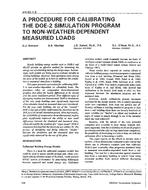Description
Hourly building energy models such as DOE-2 and BLAST provide an effective method for simulating the energy use of a building during the design stage. Increasingly, such models are being used to evaluate retrofits in existing buildings. However, little agreement exists among the users of the models as to how to calibrate the simulation to measured data from a building. Presents a procedure for calibrating DOE-2 to non-weather-dependent (or scheduled) loads. The procedure relies on comparative three-dimensional graphics that allow for hourly differences to be viewed over the entire simulation period. Four different types of day-typing routines are demonstrated. DOE-2 simulations of the case study building were significantly improved when schedules based on measured data were introduced. For the case study building, the use of the “canned: DOE-2 day-type profiles understated the electricity use by 26% for a six-month period. Most importantly, the availability of comparative three-dimensional surface plots significantly improved the ability to view small differences between the simulated and measured data, which allowed for the creation of a “super-tuned” DOE-2 simulation that matched the electricity use within 1%. The process of identifying and fixing unknown “misfits” between the simulation and the measured data was significantly enhanced by the use of the plots.
KEYWORDS: calibrating, computer programs, calculating, energy consumption, buildings, modernising, measuring, case studies, electricity consumption, comparing
Citation: ASHRAE Trans. 1992, vol.98, Part 1, Paper number AN-92-1-5, 636-652, 10 figs., 2 tabs., refs.
Product Details
- Published:
- 1992
- File Size:
- 1 file , 2.2 MB
- Product Code(s):
- D-17912




